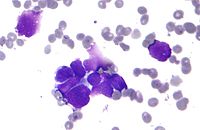
Photo from wikipedia
The α-N-Heterocyclic thiosemicarbazones and their metal complexes have been widely investigated as anticancer and antibacterial agents for their broad spectrum of pharmacological properties. Thus, two thiosemicarbazone-based Cu(II) complexes, [Cu2(ptpc)I2] (1)… Click to show full abstract
The α-N-Heterocyclic thiosemicarbazones and their metal complexes have been widely investigated as anticancer and antibacterial agents for their broad spectrum of pharmacological properties. Thus, two thiosemicarbazone-based Cu(II) complexes, [Cu2(ptpc)I2] (1) and [Cu(qtpc)I] (2) with thiosemicarbazone ligand (ptpc = 2-(di(pyridin-2-yl)methylene)-N-(2-(trifluoromethyl)phenyl)-hydrazine-1-carbothioamide, qtpc = 2-(quinolin-8-ylmethylene)-N-(2-(trifluoromethyl)phenyl)hydrazine-1-carbothioamide) were synthesized and evaluated for their biological activities. Complexes 1 and 2 are superior to cisplatin in vitro antiproliferative activities toward hepatocellular carcinoma cell line with the half maximal inhibitory concentration value of 0.2 and 2 μM, respectively. A series of spectroscopic assays and the DNA cleavage experiments showed that both complexes can change and distort the conformation of DNA. Molecular docking experiment further demonstrated that complex 1 binds to DNA mainly in groove mode. Meanwhile, benefiting from their good liposolubility, complexes 1 and 2 could easily enter cells, which further triggers cell cycle arrest and apoptosis. Moreover, complexes 1 and 2 caused serious mitochondrial damage, associating with increased the level of reactive oxygen species (ROS) and Ca2+, decreased adenosine triphosphate (ATP) content and mitochondrial membrane potential (Δψm), and transformed mitochondrial morphology. These findings indicated that complexes 1 and 2 might exert their anticancer activity by inducing DNA and mitochondrial damage simultaneously.
Journal Title: Journal of inorganic biochemistry
Year Published: 2022
Link to full text (if available)
Share on Social Media: Sign Up to like & get
recommendations!